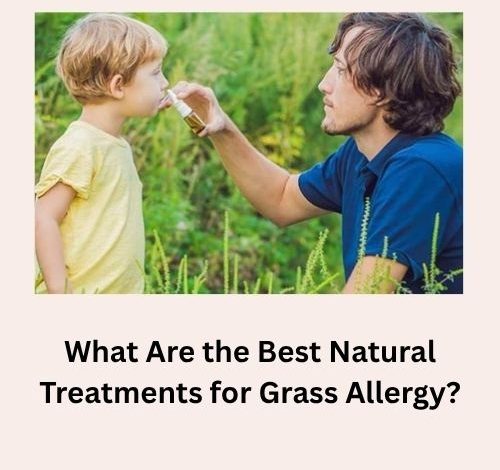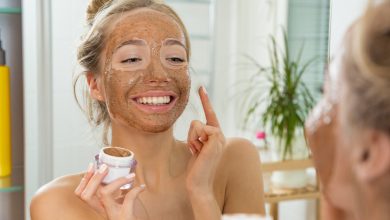What Are the Best Natural Treatments for Grass Allergy?

Grass allergies are among the most common seasonal allergies affecting millions worldwide, especially during late spring and early summer when grasses release pollen into the air. If you’re one of the many individuals who experience sneezing, itchy eyes, nasal congestion, or even asthma-like symptoms during this time, you might be looking for alternatives to pharmaceutical antihistamines. Fortunately, natural treatments for grass allergy can offer effective relief without the unwanted side effects of medications.
The most effective natural treatments for grass allergy, how they work, and how you can incorporate them into your daily routine to reduce symptoms and improve your quality of life.
Understanding Grass Allergy
Before diving into natural remedies, it’s crucial to understand what causes grass allergies. Grass pollen is a fine powder released by grasses such as Timothy, Bermuda, Kentucky bluegrass, and ryegrass during their reproductive cycle. For individuals with grass allergies, the immune system mistakenly identifies these pollen grains as harmful invaders, leading to an allergic response.

Common symptoms of grass allergy include:
- Runny or stuffy nose
- Sneezing
- Itchy, watery, or red eyes
- Coughing
- Wheezing or shortness of breath
- Postnasal drip
- Fatigue due to disrupted sleep
Why Choose Natural Treatments for Grass Allergy?
Many over-the-counter allergy medications provide relief but often come with side effects like drowsiness, dry mouth, and digestive discomfort. Natural treatments aim to support your immune system, reduce inflammation, and offer long-term relief with fewer side effects.
Let’s explore the best natural treatments for grass allergy that can help you breathe easier and enjoy the outdoors again.
Related Article: Mold Allergy Symptoms, Causes, Complications, Diagnosis and Treatment
1. Quercetin: Nature’s Antihistamine
Quercetin is a flavonoid found in apples, onions, berries, and leafy greens. It works as a natural antihistamine by stabilizing mast cells and preventing them from releasing histamine—the chemical responsible for allergy symptoms.
How to Use:
- Dietary sources: Increase your intake of quercetin-rich foods like red onions, apples with skin, kale, and broccoli.
- Supplements: 500–1000 mg of quercetin daily, often combined with vitamin C to enhance absorption.
Benefits:
- Reduces sneezing and nasal congestion
- Fights inflammation
- Enhances immune response
2. Local Raw Honey
Consuming local raw honey may help your body build a tolerance to local pollen over time. The idea is similar to allergy shots, in that small, consistent exposure may desensitize your immune response.
Related Article: Nickel Allergy Symptoms, Causes, Diagnosis and Treatment
How to Use:
- Take 1 teaspoon of local raw honey daily starting a few months before allergy season.
- Continue throughout peak grass pollen periods.
Note:
Make sure it is raw and unfiltered for maximum effectiveness.
3. Nasal Irrigation with Saline Solution
One of the simplest and most effective natural treatments for grass allergy is nasal irrigation. Using a neti pot or saline spray can help flush out pollen particles and reduce inflammation in nasal passages.
Related Article: Peanut Allergy Symptoms, Causes, Diagnosis and Treatment
How to Use:
- Mix 1 teaspoon of salt with a pinch of baking soda in 2 cups of distilled or boiled (then cooled) water.
- Use a neti pot or nasal spray bottle to rinse each nostril.
Benefits:
- Clears allergens from nasal passages
- Reduces sinus pressure and congestion
- Safe for daily use
4. Butterbur Extract (Petasites hybridus)
Butterbur is an herb that has been used for centuries to treat headaches, asthma, and allergies. Studies have shown that butterbur can be as effective as some over-the-counter antihistamines in treating seasonal allergic rhinitis.
Related Article: Penincillin Allergy Symptoms, Causes, Diagnosis and Treatment
How to Use:
- Look for PA-free (pyrrolizidine alkaloid-free) butterbur extract.
- Typical dose: 50–75 mg twice daily.
Caution:
Do not use raw butterbur as it contains liver-toxic compounds. Always choose standardized extracts from reputable sources.
5. Stinging Nettle (Urtica dioica)
Stinging nettle is another powerful herb known for its anti-inflammatory and antihistamine properties. It can naturally block histamine receptors and reduce allergy symptoms like sneezing and itchy eyes.
Related Article: Pet Allergy Symptoms, Causes, Diagnosis and Treatment
How to Use:
- Tea: Steep 1–2 teaspoons of dried nettle leaves in hot water for 10–15 minutes.
- Capsules: 300–600 mg per day as a supplement.
Benefits:
- Fast-acting relief from allergy symptoms
- May also support joint and prostate health
6. Probiotics for Immune Balance
Probiotics help regulate immune function and reduce inflammation, which may be beneficial for allergy sufferers. By promoting gut health, probiotics can improve your body’s tolerance to allergens, including grass pollen.
Related Article: Shellfish Allergy Symptoms, Causes, Risk Factors, Diagnosis and Treatment
Best Strains:
- Lactobacillus rhamnosus GG
- Bifidobacterium lactis
- Lactobacillus acidophilus
Sources:
- Yogurt with live cultures
- Kefir
- Sauerkraut, kimchi, and other fermented vegetables
- Probiotic supplements
7. HEPA Air Filters
While not a supplement or herb, using HEPA (High-Efficiency Particulate Air) filters in your home can drastically reduce indoor exposure to pollen. It’s a natural environmental control method that complements other treatments.
Related Article: Soy Allergy Symptoms, Causes, Risk Factors, Diagnosis and Treatment
Tips:
- Use HEPA filters in bedroom and main living spaces
- Keep windows closed during high pollen times
- Shower and change clothes after being outdoors
8. Essential Oils
Some essential oils have anti-inflammatory and decongestant properties that may ease allergy symptoms.
Best Essential Oils for Grass Allergy:
- Peppermint Oil: Reduces sinus congestion and headaches
- Lavender Oil: Anti-inflammatory and calming
- Eucalyptus Oil: Clears nasal passages and improves breathing
How to Use:
- Diffuse into the air
- Add a few drops to a warm bath
- Mix with a carrier oil (like coconut oil) and apply to the chest or temples
9. Vitamin C
Vitamin C acts as a natural antihistamine and antioxidant. It helps lower histamine levels in the bloodstream and supports the immune system.
Related Article: Sun allergy Symptoms, Causes, Diagnosis, Treatment and Prevention
Sources:
- Oranges, kiwis, strawberries, bell peppers, and guavas
- Supplement: 500–1000 mg daily during allergy season
10. Dietary Adjustments
An anti-inflammatory diet may help reduce overall allergic responses. Certain foods can trigger or worsen allergies, while others support immune health.
Foods to Eat:
- Omega-3 rich foods: flaxseeds, walnuts, and fatty fish
- Leafy greens and colorful vegetables
- Spices like turmeric and ginger
Foods to Avoid:
- Dairy (may increase mucus production)
- Processed foods and sugars
- Alcohol and caffeine during peak allergy season
11. Acupuncture
Acupuncture, a practice rooted in traditional Chinese medicine, may provide relief for seasonal allergies by stimulating energy pathways (meridians) in the body.
Research Shows:
Studies suggest that acupuncture may reduce nasal symptoms and improve quality of life in those with allergic rhinitis.
Sessions:
- Typically done 1–2 times per week during allergy season
- Administered by a licensed acupuncturist
12. Licorice Root (Glycyrrhiza glabra)
Licorice root is another herb with anti-inflammatory effects that may ease allergy symptoms and improve adrenal function, which regulates immune response.
Caution:
Licorice root can raise blood pressure if taken in high doses or for long periods. Use deglycyrrhizinated licorice (DGL) if concerned about hypertension.
Lifestyle Tips to Enhance Natural Treatments for Grass Allergy
Combining natural remedies with healthy habits can optimize results. Consider the following lifestyle modifications:
1. Limit Outdoor Exposure
- Check pollen forecasts and stay indoors during high-pollen days
- Wear sunglasses and hats to protect your face and eyes
- Avoid lawn mowing, especially in the early morning when pollen levels peak
2. Maintain Clean Indoor Air
- Vacuum frequently using HEPA-filter vacuums
- Wash bedding weekly in hot water
- Consider a dehumidifier to reduce mold and dust mites
3. Stay Hydrated
- Water helps thin mucus and flush out allergens
- Aim for at least 8–10 glasses daily
When to See a Doctor
While natural treatments for grass allergy are effective for many, some people may experience severe symptoms that require medical intervention. If you develop:
- Persistent wheezing or shortness of breath
- Severe nasal blockage
- Hives or swelling
- Anaphylactic symptoms (rare with grass allergy but possible in severe cases)
Contact your healthcare provider immediately. You may still benefit from using natural treatments as part of a broader integrative approach.
Final Thoughts
Grass allergy doesn’t have to keep you locked indoors all season long. By understanding your triggers and incorporating the best natural treatments for grass allergy, you can build resilience and reduce the frequency and severity of your symptoms. From quercetin and nettle to honey and probiotics, nature offers powerful tools to support your immune system and restore comfort.
Whether you choose herbs, supplements, or lifestyle changes, always consult with a healthcare professional before starting any new treatment—especially if you’re pregnant, nursing, or have existing health conditions.




